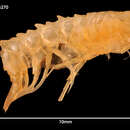en
names in breadcrumbs


“Syrrhoe nodulosa, n.sp.
Occurrence: 1. St. 170. South Shetlands. 5 ♀♀ (2 ovig.) 13-14 mm.
2. St. 181. Palmer Archipelago. 1 ♂ 14 mm., 1 ♀ 11 mm., 1 ovig. ♀ 14 mm. Types.
3. St. 182. Palmer Archipelago. 1 ♀ 12 mm.
4. St. 195. South Shetlands. 3 ♀♀ (2 ovig.) 11-13 mm.
Description. Integument not indurated, but firm, minutely shagreened. Head vaulted, rostrum reaching to just beyond middle of 1st antennal joint. Eyes prominent, ovoid, dorsally not quite contiguous. Peraeon segments 1 and 2 very short dorsally, together equal to 3rd segment, following segments increasing in length. Back rounded. Posterior margins of segments 4-7 more or less raised, prominent and, on segments 6 and 7, produced in a short medio-dorsal tooth, that on segment 7 with a tubercle in front of it. Segments 6 and 7 each with a blunt but well-marked horizontal keel just above junctions of side-plates; a similar keel or swelling also on segments 4 and 5 in some specimens. Side-plates as in crenulata. Pleon segments 1-3 each with a mediodorsal blunt tubercle, followed by a projecting tooth on the hind margin, which seen in dorsal view is notched ; whole posterior margin denticulate ; a blunt horizontal keel on each segment continuing the line of those on peraeon segments 6 and 7 ; postero-inferior angle of segment 3 quadrate. Pleon segments 4-6 dorsally rounded, posterior margin of 4 denticulate. Telson elongate, cleft almost to base, lobes contiguous, tapering to acute, minutely notched apices.
Antenna 1, 1st and 2nd joints subequal, upper margin of 1st sharply keeled, setose, distal margin on inside with upcurved tooth, znd more slender, 3rd just over half length of 2nd, flagellum 18-19-jointed, 1st joint long, accessory flagellum apparently 1-jointed, equal to first two flagellar joints. Antenna 2 a little longer than antenna 1, 5th joint shorter than 4th, both setose, especially dorsally, flagellum 13-14-jointed. Mouth-parts as in crenulata.
Gnathopods 1 and 2 as in crenulata, but 5th and 6th joints, especially in gnathopod 2, not so slender, strongly setose, with the same large serrate spine at angle of palms.
Peraeopods as in crenulata; 4th joints in peraeopods 3-5, and to a lesser extent, the 5th and 6th also, rather stouter than in Sars' figure (1895, pl. cxxxvi), and considerably stouter than in semiserrata (Stebbing, 1888, pl. li).
Uropod 1 extending not quite as far as the apices of telson, uropod 2 extending as far as, and uropod 3 only a very little beyond.
The colour of no. 1 (as preserved) is greyish, with numerous darker specks extending also over the 2nd joints of peraeopods 3-5, eyes bright salmon or orange; other specimens are dull yellowish with dark red specks, eyes yellowish. The colour in life is given in Note 142 for no. 2 as "ground colour creamy white, thorax and abdomen closely covered with small maroon spots, posterior legs broadly banded with red, eyes salmon-pink” .”
(Barnard, 1932: 150-151)